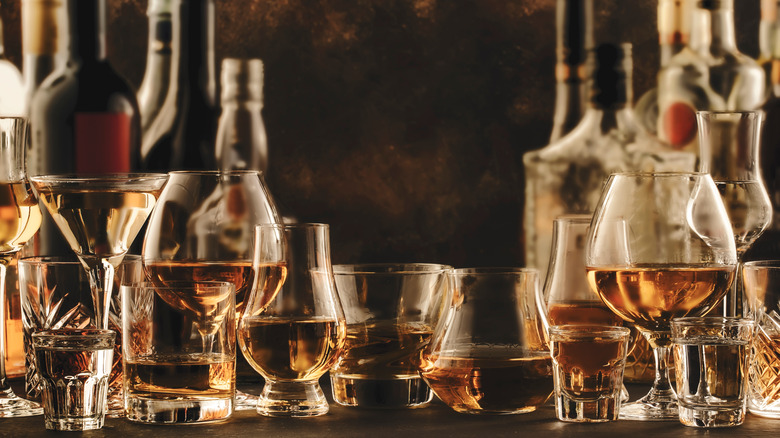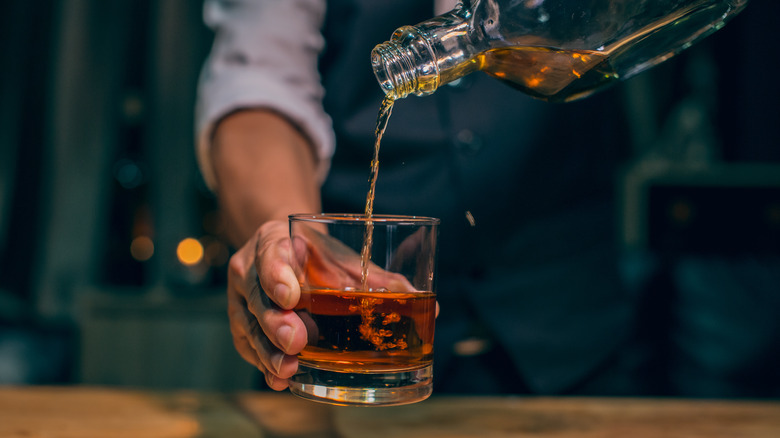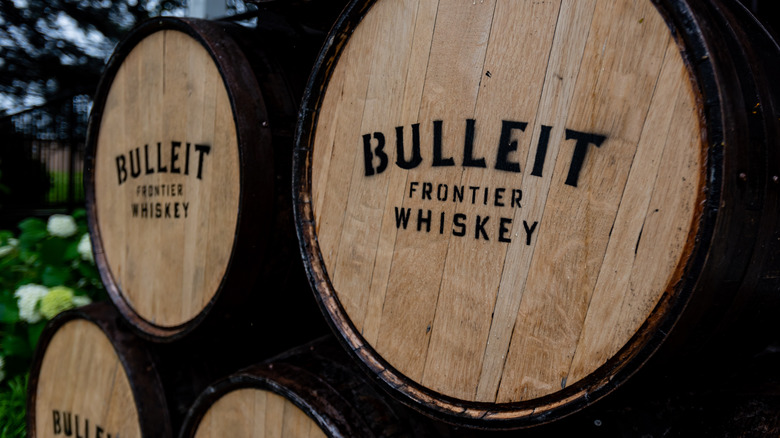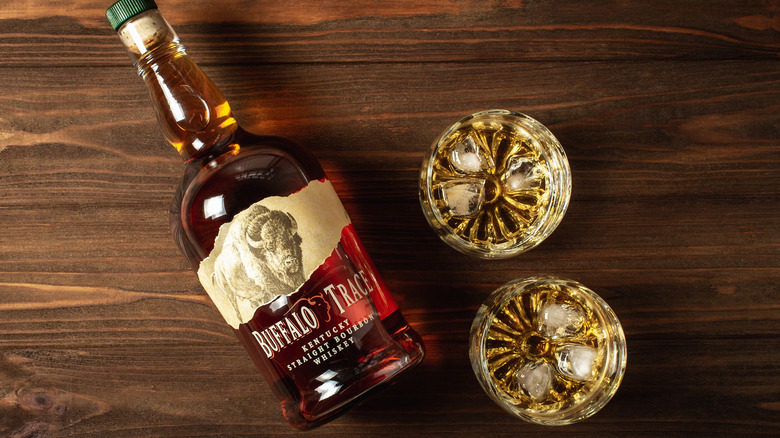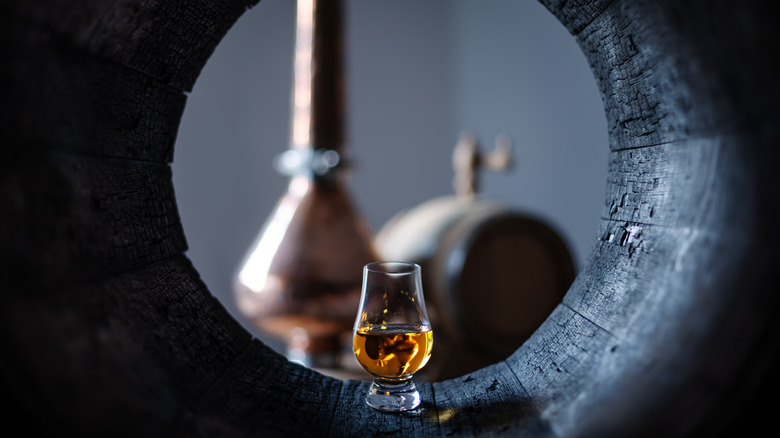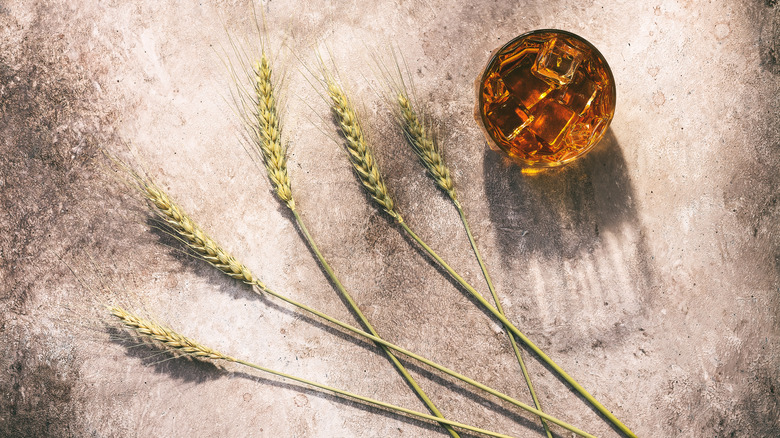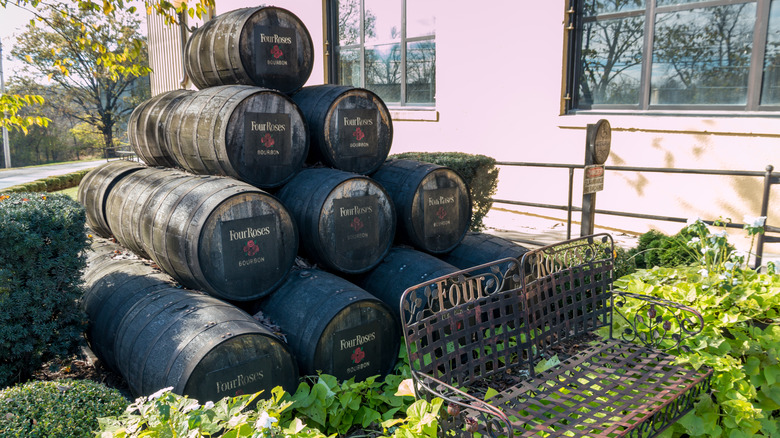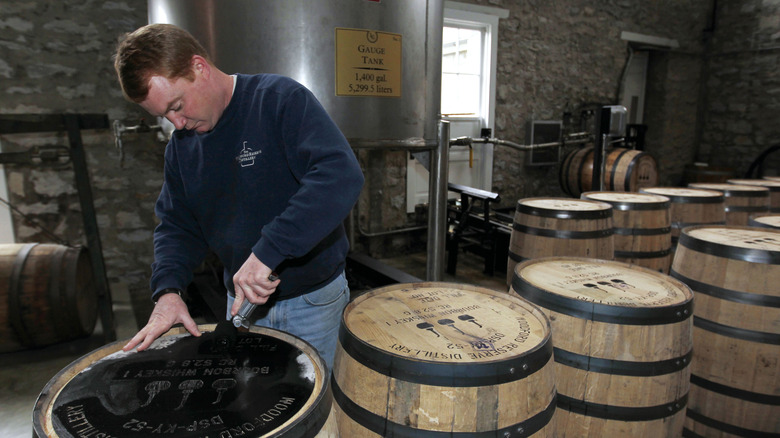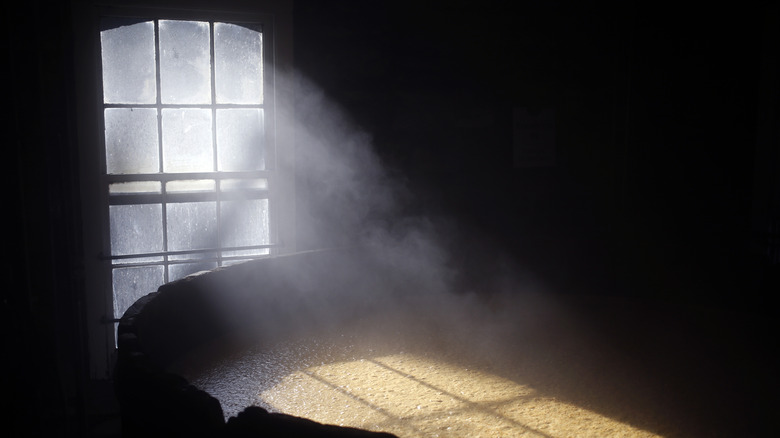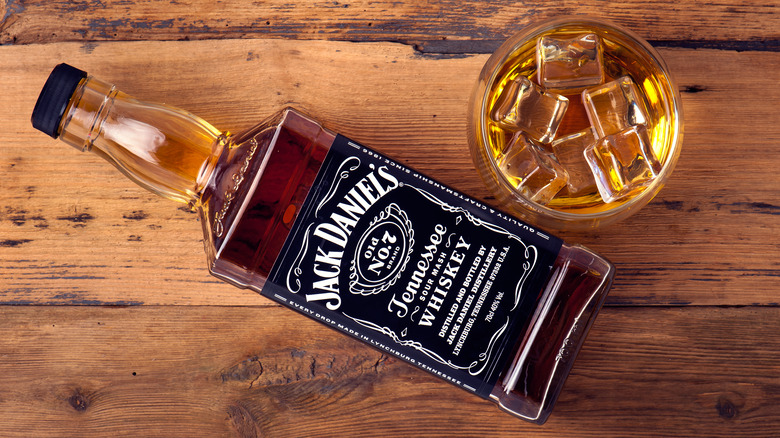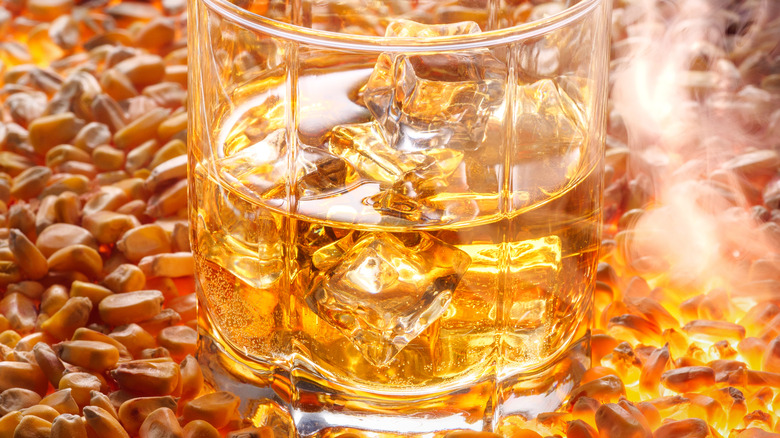Types Of Bourbon Explained
There is a well-known saying in Kentucky, "all Bourbon is whiskey, but not all whiskey is bourbon." Bourbon is a unique spirit in the whiskey family, a product of frontier-era ingenuity, it really is a picture of the melting pot of cultures in early America that each brought something to the still to blend America's own unique liquor. But within bourbon, there are differing styles, and while those styles may often cross over, it can be confusing as to what all those terms on a bourbon label actually mean.
So to help make sense of those dizzying labels, here's a quick and handy guide to understanding all 12 types of bourbon and what their labels mean. It's a great way to figure out what one likes in a whiskey, and what to look for when selecting new bottles and brands to try out in the home bar or when drinking out.
Standard bourbon
Standard bourbon, means any bourbon that meets the minimum requirements for bourbon as defined by law, which are: the whiskey must be made in the U.S., must be aged in a charred oak barrel, must be at least 51% corn, cannot enter the barrel above 125 proof but cannot enter the bottle at less than 80 proof, and nothing else can be added to the bottle except water used to adjust the proof. Making bourbon one of the most regulated spirits in the world next to cognac. That meticulous oversight ensures that even the cheapest bottle of bourbon on the shelf is still quality.
While all bourbons are technically standard bourbons, some bourbons go above and beyond, aging longer than the requirement of simply being aged, and finely tuning their mash builds beyond the required 51% corn. It may be a high minimum, but if you make sure that your whiskey is at least a standard bourbon, you know you are drinking one of the most meticulously made whiskeys in the world. Meaning that whether you reach for a mid-range bourbon like Old Forester or a bottom-shelf bottle like Old Crow, it is still more highly regulated than the tequila or vodka bottle on the same shelf. This should be the lowest tier requirement for your bourbon, otherwise, it isn't really bourbon.
Kentucky bourbon
The only thing distinguishing Kentucky bourbon from standard bourbon is that Kentucky bourbon is actually made in Kentucky. Contrary to popular belief, bourbon can legally be made anywhere in the United States, but it has to be made in the U.S. Balcones makes bourbon from blue corn in Texas, and there's even a Wyoming Whiskey Company in, you guessed it, Wyoming. Needless to say, whiskey can be made in any style all over the country. Most of it just so happens to be made in Kentucky, because there are generations of master distillers who grew up working in the state where the bourbon originated. And yes, most of the best bourbons in the world are made there.
That being said, purely calling it "Kentucky bourbon" doesn't make it so. Brands like Bulleit weren't originally made in Kentucky, it was just aged and bottled there. Much of Bulleit's bourbon and rye were actually distilled by a massive whiskey supplier called MGP in Indiana or by Four Roses, despite the label laying out a story of an heirloom family recipe. After Bulleit made a name for itself, its parent company Diageo opened a Bulleit distillery in Kentucky in 2016. We suggest looking for words other than just Kentucky on the label to ensure that you are purchasing the quality of bourbon one should expect.
Straight bourbon
Of all of the claims on the bourbon bottle, perhaps straight bourbon is the most straightforward (see what we did there?), as it simply delineates that the whiskey has been aged for more than two years in charred oak barrels. The law only requires bourbon to be aged in charred oak barrels, but doesn't specify how long it is to be aged, so making the distinction of bourbon being "straight" is just one more way of differentiating quality.
The booze enthusiasts at Distiller observe that every type of whiskey can be a straight whiskey — it can be blended, single barrel, high rye, wheated, or corn heavy — but it must follow the five rules of bourbon and must be aged at least two years in the barrel to be labeled straight bourbon. Everything from Woodford Reserve to Buffalo Trace are considered straight bourbon, and while it is a fairly low benchmark, it is a good rule of thumb to make sure that whatever bourbon we buy is at the very least a straight bourbon.
Bottled-in-bond bourbon
The Bottled-in-Bond Act of 1897 was passed to ensure consumers of a liquor's quality, but also to provide tax incentives for distillers to produce a higher quality product. Before the act had been passed, there was little to no regulation on what went into whiskey in the fledgling nation, and consumer trust dipped in American-made liquor, but the Bottled-in-Bond Act was passed to regulate the ingredients and process by which liquor was made and aged. The law required that it be made by a single producer in a single season, that it be aged for at least four years in a federally bonded warehouse, and that it be bottled at 50% ABV. In return, distillers' taxation on the product was delayed until it had completed its aging process and was ready to go to market.
To this day bottled-in-bond still represents a high mark of quality in a bourbon, and is a sure way of selecting a quality bottle. Classic brands like Jim Beam, Old Fitzgerald, and George Dickel have Bottled-in-Bond labels, but newer brands are beginning to release their own B-n-B bourbons like FEW Spirits out of Illinois, and McKenzie Distilling from the Finger Lakes region of New York.
High rye & wheated bourbon
Rye and wheated whiskeys are two very different sides of the same coin. Bourbon is required by law to be made of at least 51% corn, the rest of that mash build is largely up to the distiller's discretion, but is usually comprised of barley, wheat, and rye. High rye and wheated bourbons are bourbons that lean heavily on either the rye or the wheat to achieve the desired outcome, and people tend to have fierce opinions as to which they prefer.
Rye heavier whiskeys are deeply aromatic, with heavy scents of baking spices and fruit, and have a reputation for being rustic and bold. Lovers of rye bread will likely love a good rye-heavy bourbon, since the wheat is swapped out for rye, which comprises a whopping 20-35% of these bourbons. Jim Beam, Four Roses, Old Gran Dad Bonded Bourbon, and Bulleit Straight are among the more reputable high rye offerings.
Wheated bourbons, on the other hand, are far more mellow, with grassy and minerally aromatics. These whiskeys tend to be on the sweeter side of things, what many novice drinkers term as "smooth" — a phrase we find grossly overused. Notable wheated bourbons are Maker's Mark, Larceny, Pappy Van Winkle, and W.L. Weller.
So the question is really what one prefers: the loud and proud rye or the soft and shy wheat?
Blended bourbon
Much in the tradition of Irish, Canadian, and even Scotch whiskeys, bourbon has its own legacy of quality blended whiskeys. Though it is less common now than it used to be, you may be familiar with a few of the more famous blended bourbons. Pappy Van Winkle is perhaps the world's most famous and expensive blended bourbon, for example, their 23-year-aged bourbon sells for over $17,000. A blending of selected barrels of 23-year-aged Buffalo Trace and Van Winkle, the family brand carefully curates a perfect mix that has become a global standard for quality bourbon.
Since Pappy is a bit out of our price range, we suggest the more budget-friendly Four Roses. Most bourbons use a generic brewer's yeast, but after being absorbed by Seagram in the 1940s, Four Roses developed its own yeast strains. Any brewer will tell you that yeast is key to the flavor of all beer, whiskey is essentially a distilled beer, and Four Roses believes that the same logic should follow. The distillery uses its five proprietary yeast strains to create 10 bourbons which they blend together to create their Bourbon, Small Batch, and Small Batch Select whiskeys.
Neither Pappy nor Four Roses list the fact that they are blended whiskeys on their bottle — we suspect that is to distinguish themselves from cheap jug blends — but it is also clear that both brands take pride in the art of blending a perfect bourbon.
Small-batch & single barrel-bourbon
A lot of claims can be made about a bourbon barrel, some of which are clearly hogwash, but some labels carry more weight than others. "Small batch" and "single barrel" are such terms.
When a bourbon is labeled single barrel, it means precisely what it says: that the whiskey in that bottle came from a single barrel of whiskey. As booze blog the Barrel Mill notes, no two barrels of whisky taste alike, and most vintages of bourbon are blended together to make a single vintage, so by dedicating a single barrel to taste by itself, one gets a more unique, one of a kind bourbon; something that can't be recreated. Notable single barrel options are Four Roses and Russel's Reserve.
Small batch bourbons can be a little trickier as there is no singular definition for small batch. It can mean a few select barrels blended for a specific taste, or it can be a single pot still selection like one of our favorites, Willett's Pot Still Reserve. Or, even more bizarrely, it could be like Buffalo Trace's experimental collection of highly off-the-wall experimentations whiskeys and bourbons. But of all of the myriad meanings of "small batch," one thing it certainly means is that it isn't just a standard bourbon, it's usually something special.
Sour mash bourbon
We've all seen the prominent proclamations of "sour mash" on such labels as Jack Daniel's and George Dickle. But we've also noticed that neither of those brands tastes particularly sour, which leaves us thinking, what is sour mash, anyway?
As whiskey connoisseurs the Whiskey Mash point out, that sour mash is a process of regulating the ph levels during the early stage of fermentation, during the initial brew of the mash, in which a little of the spent grain from the previous batch is mixed in with the fresh batch. While a lot of whiskeys and bourbons utilize this process to ensure an even and consistent product, certain brands do it more than others, sometimes with up to ⅓-¼ of their mash build being backset mash.
Sour mash is an interesting part of the whiskey making process and it can make a product more consistent over time. For those interested in exploring more of the world of sour mash whiskeys, we highly recommend picking up a bottle of Michter's.
Tennessee whiskey
Long before Chris Stapleton hit the stage and drove up the sales of Jack Daniel's, Tennessee whiskey became a fixture of American distilling. While Tennessee whiskey is technically a type of bourbon, as it tends to follow the same rules, there is one key distinction known as the Lincoln County Process. By Tennessee law, Tennessee whiskey's fresh distillate must be slowly filtered through charcoal chips before being barrel-aged.
There has always been a hot debate among distillers as to whether charcoal filtering is a good or bad thing. While one could easily think that this process might add flavor to the product, it couldn't be more opposite. The process is used in everything from water filtration to air filters, and, as home distilling podcast and consultants Still It point out, in nearly every case it removes flavor from the product. Commonly used to cover up mistakes in distilling or remove toxins from the air, it seems like overkill when making flavorful whiskey.
Still, prominent Tennessee whiskey brands like Jack Daniel's claim that by stripping the alcohol's chemical compounds, it makes for a smoother tasting whiskey. We're not sure how we feel about that claim, but it bears pointing out that the most prominent Kentucky bourbon to undergo charcoal filtering, Heaven Hill's namesake green and white label, is the brand's bottom-shelf whiskey, priced at $14 per liter.
Corn bourbon
The differences between whiskey and bourbon are subtle but distinct. According to Men's Journal, both spirits are made from fermented grain that's been aged in barrels, while bourbon is specifically aged in oak caskets from a mash, or grain mixture, consisting of at least 51% corn. Barley, rye, and/or wheat make up the rest of the mash, but if the corn content comprises 80% to 100% of the mixture (per Distiller), then the resulting spirit is corn whiskey. If the product then spends its aging process inside of an oak barrel (used or uncharred), then that corn whiskey is thus corn bourbon.
Corn bourbon is very similar to moonshine, which is an umbrella term for any illegally produced alcoholic spirit, but which is usually made partially or entirely from a corn mash. Also like moonshine, corn bourbon is relatively obscure, produced almost entirely by small, regional distillers in limited batches. The corn bourbons reportedly smell and taste a bit like its mother product — sweet, hearty, and wholesome.
